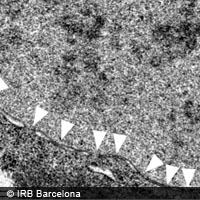Researchers uncover secrets of cell division
Researchers from the Institute for Research in Biomedicine (IRB) in Barcelona, the European Molecular Biology Laboratory (EMBL) in Heidelberg and the Pasteur Institute in Paris have published a paper in the journal Current Biology where they have isolated a protein essential for the assembly and structure of the cell nucleus. DNA division is, according to arch-evolutionist Richard Dawkins, the very essence of life, and he considers all living things to be merely vehicles for the very ancient DNA hidden within the nucleus of every cell. At the dawn of life, a few billion years ago in the primordial soup, DNA strands would have existed without any physical protection - just loose molecules adrift in the early oceans. As the molecules divided and divided again, small imperfections would emerge, and some of these imperfections would have great advantages. We, and all living things around us, are the result of billions of years of refinements, natural selection and chance mutations. While inside us rests the DNA molecules, which contain the blueprints for our physiology. In order to maintain its journey, DNA still needs to divide, but the process is now more complicated. Within cells, DNA strands must be dismantled, split, and reassembled inside the nuclei of two new cells. For this to happen, a protective membrane surrounding the original cell's nucleus must be broken and reassembled in a highly complicated procedure. Inside the cell, the nucleus is protected from the rest of the cell by an 'envelope'. This envelope regulates what passes through to the nucleus and its precious cargo of DNA. Molecules permitted to pass through are regulated by basket-shaped passageways called nuclear pores. 'We haven't yet identified all the molecules in the nuclear envelope, and many questions remain about the process by which molecules are granted or denied passage,' says IRB's Dr Peter Askjaer. The research pinpoints a protein called MEL-28 as a component of nuclear pores in a worm, C. elegans, an organism popular with researchers. MEL-28 is one of the building blocks of the envelope. When the team blocked MEL-28 activity, they found that when cells split, the envelopes protecting the nucleus could not rebuild properly, and the component parts of the envelope scrambled, so that the membranes could not be properly regulated, and no longer function properly. In humans, there is a protein very similar to MEL-28, and further research will examine whether this molecule plays a similar role. Some genetic diseases, such as the premature ageing disease progeria and some muscular dystrophies cause people to display oddly-shaped nuclear envelopes 'Understanding how the nuclear envelope forms in the first place may eventually help us understand how changes in it can cause these diseases and potentially how they can be treated,' said Dr Askjaer.
Countries
Germany, Spain, France



